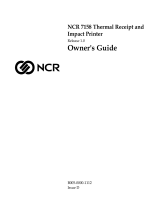
Contents 7193 Service Guide
August 1998viii
Chapter 4: Troubleshooting 33
Operator Panel Lights............................................................................................................. 33
Field Effect Transistors (FETs))............................................................................................. 34
Operating Problems................................................................................................................ 35
Electronic Problems ................................................................................................................ 37
Printing Problems ................................................................................................................... 37
Chapter 5: Disassembling and Reassembling the Printer 39
Getting Started......................................................................................................................... 39
Tools................................................................................................................................... 39
Removing the Receipt Cover.......................................................................................... 40
Removing the L Cover..................................................................................................... 41
Removing the Print Mechanism and PC Board Assembly................................................ 42
Separating the Print Mechanism and PC Board Assembly ............................................... 44
Disconnecting Cables....................................................................................................... 45
Disassembling the Print Mechanism .................................................................................... 46
Removing the Knife Assembly....................................................................................... 46
Replacing the Knife Assembly ....................................................................................... 47
Removing the Printhead ................................................................................................. 48
Replacing the Printhead.................................................................................................. 49
Removing the Knife Motor............................................................................................. 49
Replacing the Knife Motor.............................................................................................. 50
Removing the Switches................................................................................................... 50
Replacing the Switches.................................................................................................... 51
Removing the Paper Feed Motor................................................................................... 51
Replacing the Paper Feed Motor.................................................................................... 51
Disassembling the PC Board Assembly............................................................................... 52
Removing the ESD/EMC Shield.................................................................................... 52
Replacing the ESD/EMC Shield .................................................................................... 52
Replacing the Print Mechanism ............................................................................................ 53
Replacing the PC Board Assembly on the Print Mechanism ..................................... 53
Reconnecting the Cables and Harnesses....................................................................... 53
Replacing the Print Mechanism ............................................................................................ 54
Finishing Up ............................................................................................................................ 54
Replacing the L-Cover..................................................................................................... 54
Replacing the Receipt Cover........................................................................................... 54
Checking out the Printer................................................................................................. 54
Appendix A: Specifications 55
Features .................................................................................................................................... 55
Reliability ................................................................................................................................. 55
Environmental Conditions..................................................................................................... 55
Power Requirements............................................................................................................... 56
Dimensions and Weight......................................................................................................... 56
Printing Specifications............................................................................................................ 57
Density of Receipt Print Lines............................................................................................... 58
Duty Cycle Restrictions (Printing Solid Blocks).................................................................. 58























